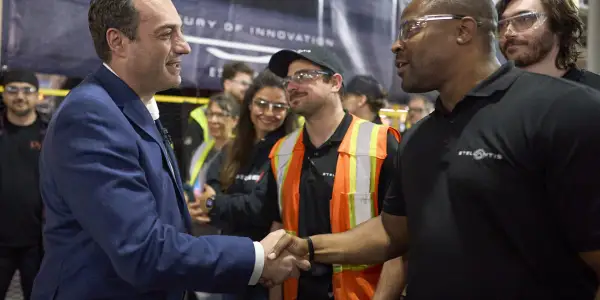Incoming Stellantis CEO Confronts a Storm of Challenges at the Helm
By Roy J. Miles

The appointment of a new CEO at Stellantis, one of the world’s largest automakers, comes at a pivotal and turbulent time for the global automotive industry. With the departure of longtime leader Carlos Tavares on the horizon, his successor steps into a role that is as demanding as it is strategic — and inherits a to-do list that is both urgent and unforgiving. At first glance, Stellantis is a global giant with seemingly solid footing. Born from the 2021 merger of Fiat Chrysler Automobiles and PSA Group, the company owns iconic brands such as Peugeot, Jeep, Fiat, Dodge, Chrysler, Citroën, Alfa Romeo, and more. Its revenues top €180 billion, and its geographic reach spans North America, Europe, Latin America, and growing footprints in Asia and Africa. But beneath that surface, the incoming CEO faces a landscape of major challenges, both internal and external — from navigating the shift to electric vehicles (EVs), to responding to economic volatility, labor disputes, and increasing pressure from regulators and investors. Perhaps the most pressing issue is the global EV transformation. Stellantis has publicly committed to selling only electric vehicles in Europe by 2030, with similarly ambitious targets for the U.S. and other markets. That pledge is ambitious — and expensive. The group is investing over €50 billion in EV development, battery production, and software integration. However, competition is fierce. Tesla continues to lead the market, while Chinese manufacturers like BYD and Nio are making aggressive moves into Europe. Legacy rivals like Ford, GM, and Volkswagen are also accelerating their electric transitions. For Stellantis, this means innovating quickly without alienating customers still reliant on combustion engines. It also means navigating supply chain volatility for critical components like batteries, semiconductors, and rare earth materials — many of which are politically sensitive and vulnerable to global tensions. Another major test is labor relations. As Stellantis restructures and modernizes operations, it has announced plant closures, workforce reductions, and cost-saving initiatives. In France, Italy, and the U.S., labor unions have responded with strikes, legal threats, and public opposition. The new CEO will need to balance profitability with social responsibility, all while keeping factories efficient and employees motivated in a rapidly changing industry. On the political front, Stellantis must juggle relationships with multiple governments. It receives subsidies and policy support in Europe and North America but is also subject to tough regulatory scrutiny. Whether it’s complying with Europe’s Green Deal, meeting new U.S. fuel-efficiency rules, or managing trade uncertainty around China, the next CEO will have to be a diplomatic operator as well as a business strategist. Stellantis is also in the midst of a digital and software overhaul. The company has promised to generate €20 billion in annual software revenue by 2030, through connected car services, over-the-air updates, and mobility platforms. But that target remains distant, and integrating advanced tech across so many brands and platforms is a colossal challenge. The group’s STLA Brain, STLA SmartCockpit, and STLA AutoDrive platforms are still in the rollout phase, and delays could put it behind rivals with more focused offerings. Internally, leadership transition always brings uncertainty. Carlos Tavares was seen as a demanding but highly effective CEO, credited with turning around PSA Group and executing the Stellantis merger with precision. His departure leaves big shoes to fill. The incoming chief must rally a complex executive team spanning multiple nationalities, cultures, and corporate identities — all while ensuring that core financial performance doesn’t suffer during the transition. Analysts say investors will be watching closely for any signs of strategic drift or missed targets. With economic uncertainty rising — from inflation and interest rate volatility to geopolitical instability — cost control and execution will be critical. The new CEO will be expected to maintain profitability, manage debt, and deliver strong results quarter after quarter, even as the company embarks on long-term transformation. Still, the new leader isn’t starting from scratch. Stellantis remains profitable, and its diversified brand portfolio provides a degree of insulation from regional shocks. Its strong foothold in North America, especially through Jeep and Ram, provides high-margin returns, while growth markets in Latin America offer room for expansion. Its European brands, particularly Peugeot and Opel, continue to evolve in design, technology, and emissions performance. What’s more, the company has made strategic investments in battery manufacturing, including its gigafactory joint venture with TotalEnergies and Mercedes-Benz through ACC (Automotive Cells Company). These will be key in ensuring energy independence and cost competitiveness as EV volumes scale up. Despite the storm clouds, many insiders see the new CEO appointment as an opportunity to inject fresh energy and direction into Stellantis. Some expect a stronger push into premium and luxury segments, where margins are higher. Others believe the new leader may double down on software partnerships or look to acquisitions to strengthen AI, autonomous driving, or charging infrastructure capabilities. In the end, the success of Stellantis’s next CEO will depend not just on vision, but on adaptability, speed, and execution. The automotive world is undergoing the most profound shift in a century — from fossil fuels to electric, from driving to autonomy, from ownership to mobility-as-a-service. It is a high-stakes game with winners and losers. For Stellantis to stay on the winning side, its next CEO will need to move fast, unite a diverse organization, manage global complexities, and never take an eye off the bottom line. In short: the hardest job in the auto world just got harder.